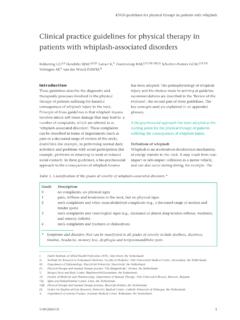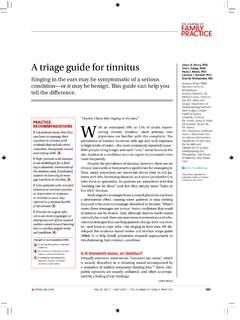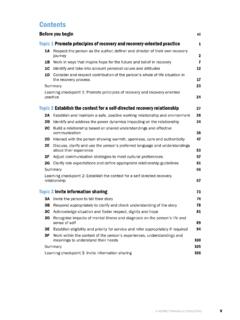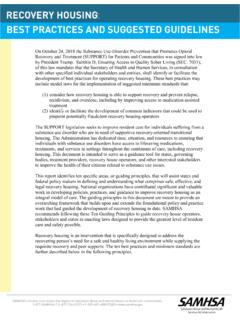Transcription of The road to recovery - a history of mental health services ...
1 The road to recovery - a history of mental health services in Queensland 1859-2009 From institution to community In the early days of Queensland s history , it was assumed that people with mental illness had no capacity to look after themselves and should be separated from the rest of society. In the 1950s, new ideas about the organisation of psychiatric care shifted the emphasis from custodial care in large, closed institutions to supporting patients to live in the community. Increasing numbers of patients were discharged and fewer admitted, and allied health professionals became involved in preparing patients for life beyond the walls of the institution.
2 Today, it is recognised that many risk factors for mental illness lie beyond the health system, and relate to aspects of our everyday lives. These aspects include material well-being, housing, education, community inclusion and acceptance and employment. There is growing recognition that a whole-of-government, whole-of-community approach is necessary to reduce the prevalence and impact on the mental health of individuals, their families, carers and communities. In response, Queensland health , as part of the Queensland Plan for mental health 2007-2017, committed $ million over the four years to 2011 to strengthen the capacity to coordinate care for consumers with complex needs living in the community.
3 Changing community attitudes Community attitudes towards mental illness in Queensland have been complex and contradictory over the past 150 years, with public discourse demonstrating a mixture of both fear and concern. Widespread social attitudes and values of colonial Australians influenced how people suffering from mental health issues were perceived by the community. Hard work, individual effort and virtuous living promised to bring success and security to individuals able to live up to these ideals. People who did not, particularly those considered insane , were seen to be responsible for their illness due to moral weakness and personal deficiency.
4 Mentally ill people were popularly considered dangerous and were confined and separated from the broader society. The location of asylums away from large population centres reflected this principle. mental illness was out of sight, and mostly out of mind. Psychiatrists and other health professionals tried to influence the public perception of mental illness so it was regarded as an illness like any other. Recommendations for changes including those relating to opening mental health units in general hospitals and introducing the concept of voluntary admissions were specifically directed at reducing the stigma attached to individuals with mental illness.
5 When the first ward of this type was opened in at the Brisbane General Hospital in Queensland in 1918, Dr Henry Byam Ellerton commented: This ward was built to meet a long-felt need namely, to supply suitable accommodation where patients with impending mental breakdown, or even acute mental cases in their initial stages, might receive all the advantages of medical treatment and skilled nursing without the stigma of certification as insane. People who live with mental illness still experience stigma and discrimination. The results of stigma can often be worse than the illness itself, particularly when people face discrimination finding employment, a place to live, satisfactory health care and connections to other people.
6 This stigma has tragic consequences. Many people with mental health problems fail to seek treatment because of the shame associated with their illness. Advocacy and consumer participation While there have always been critics of asylums and institutions, advocacy for patients with mental health issues was formalised in Queensland in the 1940s with the formation of the Relatives of the Mentally Ill Association. The Association made frequent approaches to government over conditions at the Goodna mental Hospital and raised issues such as increasing the quality of meals and clothing for patients, improving recreation facilities and establishing an after-care home for patients who resided in the institution because they had nowhere else to go.
7 The civil rights movement of the 1960s and 1970s raised awareness of the rights of minority groups, including people with mental illness. In 1977, the Queensland Department of health established the Office of the Patients Friend to advocate for individual rights including the right to be consulted about treatment, the right to be protected from abuse, and the right to be free from unnecessary controls. Various non-government organisations have also been established to advocate and support people with mental illness and their families and carers.
8 The mental health Association (Queensland) was established in 1961 in response Goodna, and the Association of Relatives and Friends of the Mentally Ill (ARAFMI ) was formed in 1977. Both of these organisations continue to provide services in the present day to the conditions at As the human rights movement gained momentum, the voices of patients themselves emerged as a force for change. One objective was to shift the balance of power to place mental health service users on an equal footing with professionals. In recognition of the expertise that mental health consumers have in their knowledge of mental illness, current health policy in Queensland supports the active participation of consumers, families and carers in all aspects of policy, planning and services .
9 recovery The concept of recovery is an emerging paradigm in mental health services that focuses not on a patient being cured , but of individuals living meaningful lives with mental illness. recovery acknowledges that having a mental illness does not necessarily mean life long deterioration, but focuses on an individual s journey toward a sense of identity, role and purpose beyond the boundaries of mental illness. The recovery approach focuses on the person experiencing improved quality of life and higher levels of functioning despite their illness, rather than solely on reduced symptoms or the need for treatment.
10 To read more about recovery - oriented service provision click on the link below: Sharing Responsibility for recovery : creating and sustaining recovery oriented systems of care for mental health (PDF, 505KB) Patient rights The Queensland mental health system is based on a framework which encompasses fundamental rights and responsibilities for all people who have a mental illness, including the following: People with a mental illness are entitled to respect for their basic human rights, confidentiality, and must be able to participate in decisions made about them.
















